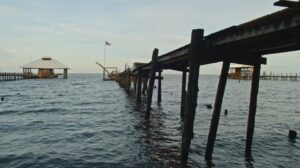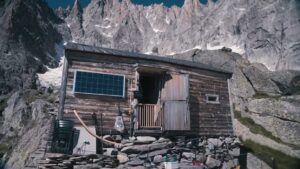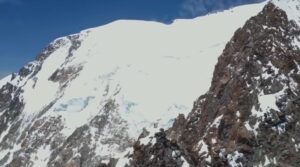The very first shot in Heavenly Trap, the 36-minute documentary of Marek Holecek and Radoslav Groh’s harrowing 2021 climb, is of Kathmandu. “Worse than Baruntse,” Holecek jokingly called it when they shuffled into the city after nine days on the mountain. We cut to a hospital, where Holecek and Groh are looking rather worse for wear. It’s an appropriately heavy start.
But like the start of a Hollywood thriller, we then need to rewind a bit. We are taken back to the beginning of their journey, arriving in Kathmandu just before COVID closed international travel into Nepal.
Lucky to have made it into Nepal, the duo trek through the central Himalaya to acclimatize. The weather is warm, and they arrive at Buruntse questioning whether their climb will even be possible. Will there be enough snow? Will there be enough ice? They hope to complete a new line on the 7,129m peak, a tough ask even in the best conditions.
Marginal weather
Holecek and Groh spend 14 days in Base Camp examining the west face and waiting on the weather. The face looks grey. Where they had expected snowfields, they find ice and bare rock.

Holecek and Groh in one of many tricky bivouacs. Photo: Marek Holecek
“I’m not a very flexible personality,” Groh says early in the film. Later he describes his nervousness increasing as they wait for a weather window. “I was afraid that the good weather wouldn’t come at all,” he explains. Perhaps this plays a role in their decision to push up Buruntse during what, at best, might have turned into a marginal period of good weather.
When they eventually begin this push, progress is slow, through unconsolidated snow and complex terrain. Almost immediately, things don’t go to plan. They are forced into two early bivouacs. Only on day three can they get started on the real climbing. But the start of the climb looks anything but a relief. We see Groh and Holecek digging in to climb up what looks like extremely hard, vertical ice. Above, the meat of the west face looms over them.
Earthwork and excavations
Their route weaves up the face, the climbers looking for patches of softer snow and ice. They soon realize that they won’t make it to their planned bivy spot. As the sun dips behind the mountains they take on the “earthwork and excavations” required to survive the night. It’s a horrific-looking bivouac, with just enough room to sit, provided you don’t mind sitting on the edge of a precipitous drop.

Baruntse, obscured by Cyclone Yaas. Photo: Marek Holecek’s Base Camp team
Day four grants some respite. They make good progress and are rewarded with a cave in which to spend the night. It spares them from digging out another platform on the face. But day five saw the return of uncertainty, bad rock, and deteriorating weather. Once again, they had to bivouac.
Trapped in their tent
Day six was another brutal slog. By the time they finally made the ridge, conditions were awful. It was snowing heavily and they “were in deep shit.” Despite everything, the two climbers summited Baruntse on May 25. But they were now trapped by the ripple effects of Cyclone Yaas, which was busy pummelling West Bengal.
By May 29, Holecek and Groh had been stuck in their tent for four days, desperately using their fuel to try and warm their extremities and finishing off the last of their food. Finally, on May 30, with both climbers and Cyclone Yaas exhausted, they managed to get far enough down the mountain to call in a helicopter.

Holecek and Groh left part of themselves back on the mountain. Photo: Marek Holecek
The pair had lost a third of their body weight but had completed their new line. Holecek and Groh dedicated Heavenly Trap (ABO, M6, VI+, 80°) to Petr Machold and Kuba Vanek, two friends who disappeared on the Northwest Face of Baruntse in 2013.
The full film on their grueling experience, below, has just come out this week.






